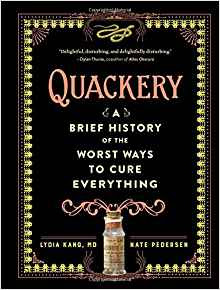
As soon as I saw Quackery: A Brief History of the Worst Ways to Cure Everything by Lydia Kang I knew that I had to get it in my hands. If the name alone doesn't intrigue you then I don't know what will. This book is full to bursting with historical facts about crazy medical practices through the ages. It is an excellent resource about the history of the medical profession as well as education and social change. Much like when I read Soonish, I felt that it was a little heavy with the 'relatable' humor but this was easily overlooked. (I think Kang pulled it off better anyway.) As someone who has read quite a bit about the history of medicine, I was surprised by just how much I didn't know. For example, did you know that leeches have 3 stomachs, 3 jaws, and 100 teeth in each of those jaws?! Kang sets up the different medical practices and procedures by first giving a history of the person that started it off (generally a 'medical practitioner' or someone at least purporting to be one). She then shares accounts from the patients who endured such crazy routines (like bloodletting or ingesting arsenic) paired with diagrams of the medical equipment used to accomplish such feats. (I hope you have a strong stomach for the bloodletting chapter.) I especially enjoyed the little asides about what we now know about the concoctions put together long ago to 'cure' and how the vast majority of them were either complete hokum or actually increased the chances of the patient suffering an agonizing death. It makes you wonder how the future generations will view our supposedly 'innovative' medicines and treatments of the sick. Will we be seen as medical charlatans and blind fools or will they take into account the socioeconomic and political climate that we live in and how that shapes our view on medicine as a whole? As you read this book (and I hope you will) ponder that very question because then perhaps you won't judge past generations quite so harshly...unless it's the guys who took Strychnine in order to increase their sex drive. Always judge those guys. 9/10
 |
| I wasn't lying about the leeches. [Source: Amazon] |
What's Up Next: HiLo Book 4: Waking the Monsters by Jeff Winick
What I'm Currently Reading: The Murderer's Ape by Jakob Wegelius

 Log in with Facebook
Log in with Facebook 






